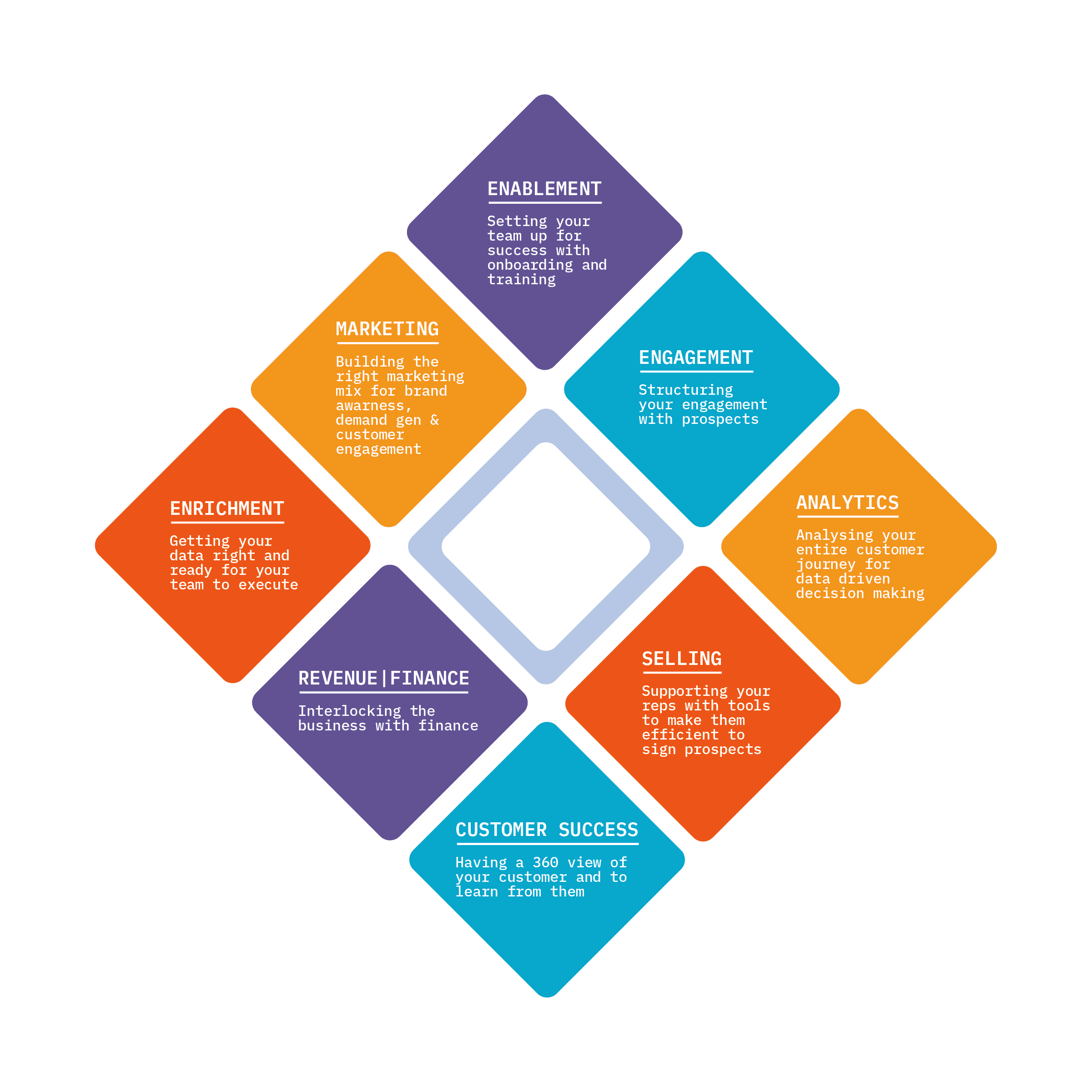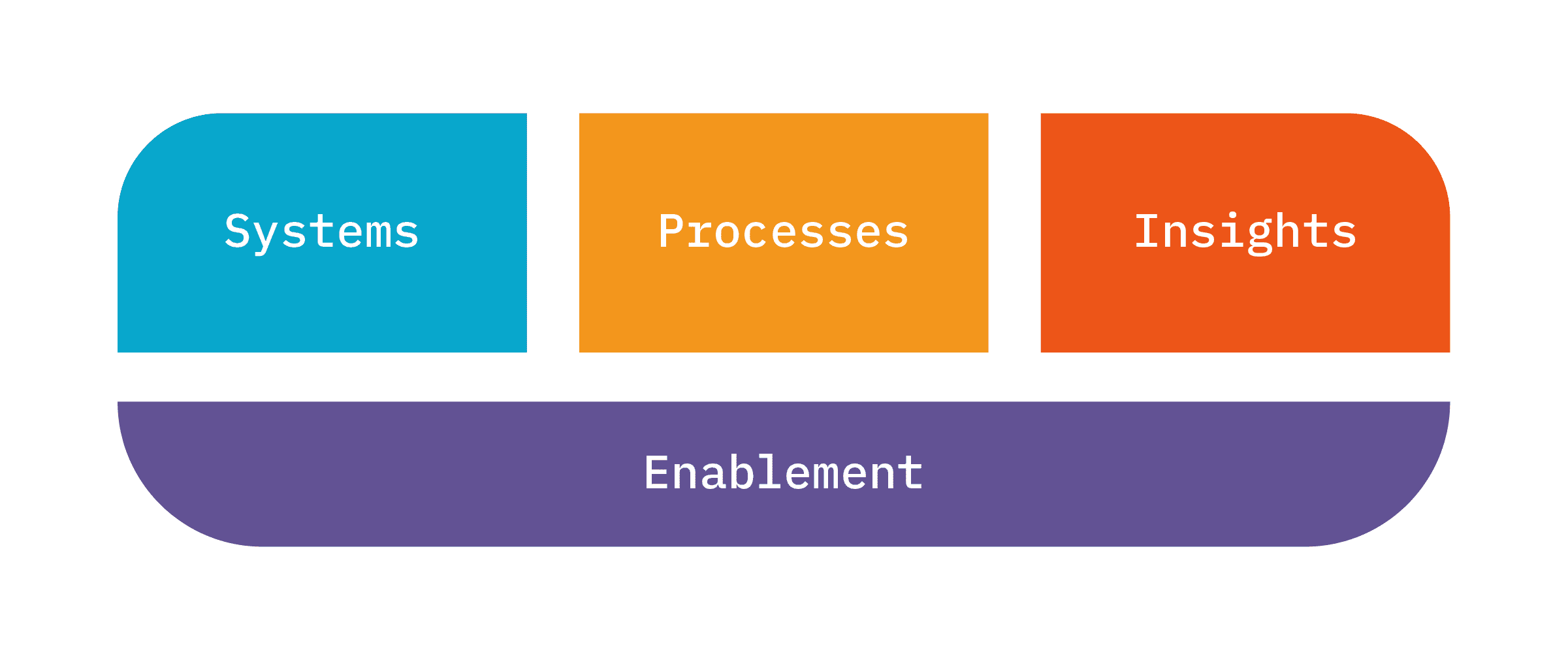As a SaaS business grows, it becomes increasingly difficult to keep up with the rapid pace of growth. Individual functions scramble for scale and tiny fissures in the revenue flow snowball into gaping voids. Every step forward is weighed down by silos.
The result is, misreported numbers, missed insights, and most importantly, unhappy teams. Should the marketing team be celebrating for achieving their targets when the sales team fell short with theirs? Are you taking the right decision with the right metrics?
Every promising SaaS business deserves hyper-growth and shouldn’t be worrying about day-to-day issues. Based on our research with Forrester, we figured that a growing company loses 20%-30% of its revenue due to operational inefficiencies. We also noticed that some SaaS leaders who spotted the untapped potential of the operations team are already spearheading the move to transform operations from an impediment to a growth catalyst.
Putting two and two together, we realized a promising SaaS company shouldn’t suffer in silence but they need an intervention into how they are doing business. We conducted the RevOps intervention, bringing together some of the most prominent voices in RevOps under one roof to make it ring louder, to speak from their experience how well one should be prepared to address pains in all areas of SaaS growth.
You can watch all the 15 videos here, but to make your life easier we have put together an actionable, step-by-step plan to ‘Rev-olutionize’ your strategies and set your SaaS business on the path to hyper-growth. The post will cover:
When is the best time to bring in RevOps?
The Intervention: Transition to a RevOps strategy
Integrating RevOps with Different Functions
How can you build an Effective RevOps army?
How do you measure the success of RevOps?
What is RevOps?
RevOps helps you build a functioning machine, and helps you determine what a company aspires to be and how it moves forward.
RevOps is a very broad topic that is still at a nascent stage. Everyone has a different version of its meaning which they apply to their organization. This is not wrong as Michael Pici from Hubspot reckons that anyone who claims to have a perfect playbook for it would be lying. RevOps makes you move towards that long term goal you and your colleagues sat late one Friday night to work towards. Revops is fundamental to take that high-level vision and translate it into a repeatable process that works.
As Ella Pebbles of Aircall says, “RevOps talks about the cogs that make a company and how it moves forward.” Even though RevOps operates many critical parts of a business, it is still a behind-the-scenes function and almost all the RevOps leaders we spoke to told us that they are susceptible to the occasional, “What is it that you actually do?” from their friends and colleagues. Hence it becomes even more important for the sake of these silent warriors and for the sake of corporate success to spread the knowledge on RevOps.
Advantages of RevOps
“The importance of the RevOps function is that you can take a million different cuts at how you can view the business but what RevOps does is, it helps us find the right ones to focus on, the thing that drives real value.” – Michael Pici, VP of Product & Revenue at Hubspot
Aligning activities to the bigger organizational goals
Michael Pici shares an example from Hubspot to highlight the importance of having clarity with Objectives and Key Results (OKR). “At Hubspot, most of the teams were aligned with functional departments focusing predominantly on the function. The VPs of these functions made lists to find the most important thing that the function is to do. When they discussed it, they found that the lists were overlapping. Seeing this, they brought all the overlapping functions under a GTM Revenue Ops team and designed a 3-year strategic marketing plan for them.” The alignment could be different but the concept of connecting the right person carrying the right question to the person with the right answer remains the same.
Facilitating an unhindered view
Michael Pici states that “The importance of the RevOps function is that you can take a million different cuts at how you can view the business but what RevOps does is, it helps us find the right ones to focus on, the thing that drives real value.” This sort of view will ensure full-funnel efficiency.
Breaking down Silos
Having a taste of multiple industries, Jay Khiroya from the House of Operations brings to light a common trend seen in scaling SaaS firms. Generally, the people working in start-ups and scale-ups are busy wearing multiple hats. Apart from their friendly watercooler interactions, they tend to work in silos. For example, when an app like salesforce is set up, usually it is consulted with the sales team and the sales ops team but not with the marketing team, though it could benefit them.
Companies don’t realize that they have all these functions working in silos until they grow bigger and they start seeing that these silos create a void which weighs them down. Bringing in RevOps at this stage would solve the problem however having RevOps from the beginning, would ensure a situation like this doesn’t arise by bringing in alignment with customers and the operations.
When is the best time to bring in RevOps?
“You should never be in a situation where you are in a bad place and want revops to step in to save you. The best way to use revops is to have the function from the beginning.” – Jay Khiroya, Founder of House of Operations.
In a podcast with SaaStr, Krish Subramanian, the Founder of Chargebee, was quoted saying. “If I were to start over, I will not only start with support but also think about Ops as early as possible.” Chloe Barritault of Button seconds this by saying SaaS-based companies should look into RevOps as early as possible as it relates to customer experience and accountability around revenue which in turn drives efficiency through integrations. Jay Khiroya adds that thinking about RevOps as a troubleshooting strategy would only end up ‘building a mess on top of a mess’. “You should never be in a situation where you are in a bad place and want revops to step in to save you. The best way to use revops is to have the function from the beginning.”
RevOps helps you start at step zero. At step zero, you create your product to solve the customer’s biggest pain. With RevOps, you keep the customer in mind and reverse engineer your way to map out the steps to achieve your organization’s goals.
The Intervention: Transition to a RevOps Strategy
Generally, product-led SaaS companies layer on enterprise sales later. Hubspot’s case was different. At Hubspot, they didn’t want to just build a product, they wanted to build a whole new way to go to the market. The bigger question came to, “How does Hubspot take this entire platform of solutions and become product-led?” Here is when they realized they had to move back to the product. In SaaS, the product drives demand and RevOps helps to identify the efficiency of every person who works to generate revenue. Hence revenue ownership has to be integrated into the DNA of a firm.
The first step to making such a transition is to understand the value proposition of your company. Jay from House of Operations highlights from his experience that many companies try to establish processes without establishing the basics. “There is no process or operation for the lack of service or structure in your operations. So first, have a clear idea of the mission. Who do we sell to? Who is our target market? The answers to these questions can evolve as the organization grows but RevOps need to get on top of this.”
Depending on the size of the business, the transition to RevOps can be complex. Transforming to automation might also mean that you’d have to forego your old ways of doing things.
To ensure a smooth transition, we noticed that 3 questions kept arising in our conversation with the leaders.
What is your ultimate source of truth?
Which function guards your ultimate truth? Is it customer success? Finance? C-level? Many teams are quoted saying that their ultimate source of truth is driven by their CRM systems. But how does every team use the CRM system to adapt to their function? When the data across the customer journey is different, how are people in different functions deciphering it to make the right conclusions?
Is everyone on the same page?
Look around you, how well do you know what the person sitting in the right corner of the office with a bonsai on his table, does? If your answer is “How should I know?”, it’s time to rethink your strategy. Everyone needs to understand what every other function is doing. Each team could perform well but they might not have an impact on the overall business.
How does one overcome the tool craze?
People can get carried away in investing in tools. Michale Pici from Hubspot says that on average, only 60% of the tool or product that an organization invests in, is used. “You might end up purchasing another product because you didn’t know that feature existed in one of the products you already use.” But with RevOps you would have transparency on implications of the product features and how they are being used by different teams.
The questions you should ask before choosing the ideal tool for your business according to Jay are,
- Where are the biggest inefficiencies in your business?
- Which areas should you focus on, to provide the best services to your customers?
- Is there a tool that can help you do your important tasks better?
- Do you have the right mix in your tools?
To know more about the RevOps Tech stack, check out our guide here.
Our experts also agree that it’s not always about having the best tech stack. Your tech stack should be based on improving what customers say about your product or about the general trends for your industry.

Integrating RevOps with different functions
RevOps can be called as ‘cross-functional’ as it places itself in the middle and enables collaboration at any level. Hence it is important to intervene in your team’s functions to bring in the RevOps change you wish to see in your strategies.
Marketing
At the end of the day, the success of the marketing team lies in having the right marketing mix. The RevOps perspective, lets you assess the same by analyzing if the business also has the right set of tools to support that mix. Michael Pici says that at Hubspot, they are “obsessed” with any problem that they are trying to solve. If that’s the case, a deeper understanding of the customer and their perspective of the problem is needed. Apart from onboarding, feedback should be collected from the prospects, across the journey. This would help to understand what is working internally.
Sales
“I felt the pain in having to pick up the phone and making cold calls”
One of our leaders started their talk with the above statement. Before the count of 3, every salesperson would be able to give you at least 5 things that they might not enjoy doing in their day to day work. To make the lives of the salesperson easy, think about the step in the process that frustrates the salesperson the most. Find ways to automate if it’s a manual process. Apart from this, another approach would be to see which process needs to be most efficient in the sales cycle and deploying a tool to ensure the required efficiency.
Engagement
In the beginning, it is easier to analyze customer engagement but as a business scales and as complex decisions need answers, a considerate investment is needed to enrich the engagement process. You would know you are ready for the RevOps upgrade when you have answers to these questions,
- Do you have the right structure to support your inbound/outbound teams?
- Does the team know what is required of them every day and how it helps engage the prospects?
- Are you looking at CAC from different sources? If so, does it give a uniform picture?
- Do you have all the data to make key decisions for your business?
If you answered most of these questions ‘no’ or ended up in a tie, there could be a gaping hole in your engagement process that needs a RevOps intervention.
Customer Success
If the key goal of the business is to give the best onboarding and product experience to your customers, RevOps helps to get a nuanced view of this data. This data will help you find any holes in the customer journey and highlight any unmet needs of the customers. Furthermore, engage with them in different ways to ensure they are getting the best of the product offering.
Finance
A general problem noticed in many companies by the RevOps leaders was that there exists a huge gap in the revenue functions and the finance teams. The root cause is that these teams look at different sets of data. Chargebee simplifies this by using 30 plus integrations to build a unified billing system. This helps the finance teams to view all their data in one space.
How can you build an effective RevOps army?
Your Revenue Operations team is only as good as the heroes who get their hands dirty with everyday tasks. There are many untapped archetypes residing in your teams but to build an efficient RevOps army with these archetypes, the following structure is suggested by Chloe.

Systems
The first thing to set in place would be the system. A deep understanding of the tech stack added with a bout of creativity and the mindset to solve a problem is necessary. The people with these skills can improve on any tech stack given to them, making it more efficient.
Process
The person should be well aware of the existing process or ways of doing things in the organization so that they can build on top of the existing stack. They can take decisions at the strategic level to change the processes going forward.
Insights
Having a business analyst who would love to deep dive into numbers to make sense of data is vital. As we know, data is used in different ways in different functions, so an agile person who can be flexible with their view of data is needed.
Apart from this, enablement makes sure that the three pillars above are acted on, gets repeated, and resurfaced all the time.
How do you measure the success of RevOps?
In SaaS, every day is a new challenge with new learning. Having a constant loop of feedback works best. However, the length of the project would dictate the ways to analyze progress as below,
Short term Goals
Big goals can be aligned with the strategies of the company and the strategy can be broken down into actionable parts. OKRs are then set up to measure the actions taken with regards to the bigger goal.
Long term Goals
Ella Pebbles from Aircall gives a few suggestions on the various analyzes that can be put in place for deciding and measuring the broader goals.
a. Pricing Analysis
Being well educated on your company’s pricing history will help you understand how much money it costs to get each customer and how much more money is needed to work on making the product better. Establish this baseline for all types of customers and separate them by industry and their business category (B2B/B2C).
b. Competitor Analysis
Analyzing your competitors will make you go back to your company’s value analysis. Ella says, “It is useful to know what the competitors are charging but it doesn’t have to dictate your prices. Work with your company to better understand your value proposition and make a case for the price that you are charging like you were to show up at the jury.” Also, the data will help find the ICP audience and their look-alikes so that the business can provide them with the value they are looking for.
c. Sales Funnel Analysis
There are many ways to focus on the leaks here. There are MQLs and SQLs on one side and on the other, there are AEs who qualify leads. Troubleshooting has to be done in a continuous way here. Unless theories are A/B tested and compared here, you wouldn’t know if the drop-off rate at any particular stage is normal or if the leads are qualified correctly.
d. Churn Analysis
It could be noticed that most of the successful RevOps leaders do early-stage analysis to track churn. With engineering and data on both the side, retention curves, and usage metrics need to be brought together to build an algorithm that works for your business. Beware of false negatives and positives caused by external factors that affect the industry.
Retrospective analysis is something that most of our leaders swear by. Questionnaires before a customer sign up asking their expectations and customer interviews for churn will make us understand who churned and why they did so. This is important as it helps to add to that feedback cycle by analyzing where a company falls sort of its expectations.
Forecasting
Forecasting is the baseline to understand how your business or industry grows. It helps categorize growth into different stages and helps establish standards. Ella says that “Forecasting helps to be proactive than reactive. Build that muscle of proactivity, if you don’t exercise it or don’t back into it, you’ll have a hard time moving the cogs without burning them out under fire drills. Ask how do I mitigate these drills to be more proactive?” As RevOps leaders who are often prone to get in the role of firefighting, this helps to understand how RevOps leaders can mitigate such fire drills to be more proactive. As more and more team members think this way, the business can be optimized for growth.
RevOps for Everyone
RevOps is an evolving function which is comprehended in different ways in different organizations. You can click here to watch all the RevOps leaders speak about how they use RevOps in their organization. But the overlying arch of these conversations lie in
- Keeping the customer experience at the center of the problem you are solving
- Integrating the communication between finance and GTM functions to enable not only quick actions but also to reduce duplication of work which leads to redundant expenses.
- A deep analysis of the metrics to make this process as iterative as possible.
If you’d like to gain a deeper understanding of RevOps in the context of SaaS, take a look into our comprehensive guide to revenue operations in high-growth SaaS.
At Chargebee we have a RevOps platform that focuses on these key aspects and much more. Venture through our RevOps offerings and make the decision for yourself. You can also schedule a free personal consultation session to learn more.

